Easy Way to Erase Former All Group Policy From Windows Vista
Grouping Policy Direction is a feature reserved for the Professional, Enterprise, and Pedagogy editions of Windows. Only with a few tweaks, Home users can enable the Local Grouping Policy Editor, or y'all can use a third-party tool to admission a more than comprehensive drove of settings. We show you both options.
Update: Recent versions of Windows 10 have decoupled settings available in the Local Group Policy Editor in Windows 10 Abode. You might still see the all settings mentioned beneath, but changing them might non have an issue on your system.
How to Open up the Local Grouping Policy Editor
You tin access the Local Grouping Policy Editor in several ways.
Here are the ii most convenient ones:
- Printing Win + R to open the Run menu, enter gpedit.msc, and hitting Enter to launch the Local Group Policy Editor.
- Printing Win to open the search bar or, if you're using Windows 10, press Win + Q to summon Cortana, enter gpedit.msc, and open up the respective event.
If this doesn't work, you either don't take Ambassador privileges, or you're running Windows Home and don't take access to the Local Group Policy Editor.
Fortunately, yous don't take to upgrade to the Pro edition of Windows to tweak group policies. We explain how to enable the Local Grouping Policy Editor on Windows Home below, but we recommend checking out the following third-party tool showtime.
How to Configure Windows Settings Without the Group Policy Editor
Before yous try to enable the Local Grouping Policy Editor, consider using a more than convenient and more powerful alternative. Policy Plus is an open up-source tool that gives you access to settings in the Group Policy Editor and the Windows Registry.
Policy Plus is compatible with all Windows editions. It requires .NET Framework version 4.v or upwardly. We recommend installing the more stable Release build. Once installed, become to Help > Larn ADMX Files, double-check the destination folder, and click Brainstorm to download additional administrative templates.
If you've always dabbled with the native Windows Group Policy Editor, the interface of Policy Plus volition look familiar. The categories in the left-hand cavalcade, however, follow a slightly different logic that we find easier to navigate.
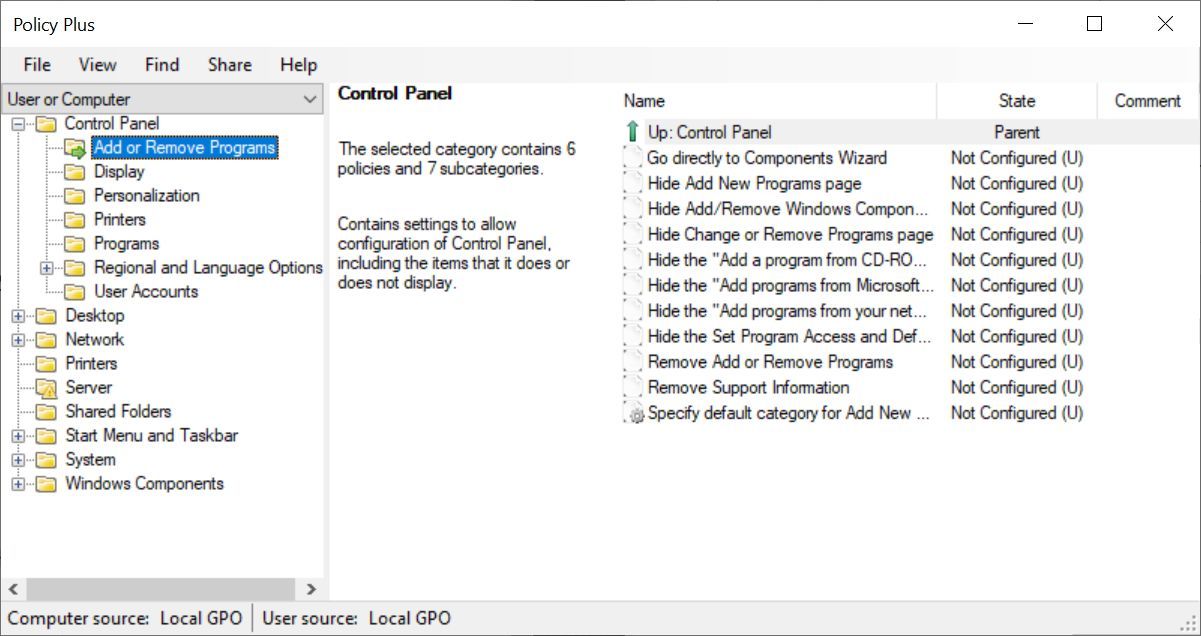
If you're using the Windows Abode edition, switch to encounter settings in the Computer category merely, since your system will ignore changes to per-user Grouping Policy Objects; yous'll need to brand those changes in the Windows Registry instead.
Changing the settings works merely similar information technology does in the Group Policy Editor; more on that below. Annotation that if you're using Windows Home, you'll accept to restart or log off and back on to activate changes.
How to Enable the Local Group Policy Editor in Windows Home
Whether you're on Windows Vista, Windows 7, Windows viii.one, or Windows 10 Habitation, you can enable the Grouping Policy Editor using one of the two solutions below.
Solution 1: Use the Add GPEDIT.msc Installer
The proper installation with this tool requires a couple of tweaks and .Cyberspace Framework version 3.5 or higher.
Offset, head to C:\Windows\SysWOW64 and copy these items:
- GroupPolicy binder
- GroupPolicyUsers folder
- gpedit.msc file
Then open C:\Windows\System32 and paste the items you but copied.
Now download the Add GPEDIT.msc Zip file from DeviantArt user Drudger and install it on your estimator. You will need a DevianArt account.

Following the installation, you will find the tool under C:\Windows\Temp\gpedit. You might accept to manually navigate to that folder.
If your Windows username contains more than than one word, you might have to adjust your installation. Right-click x64.bat or x86.bat, depending on whether your system is 64-bit or 32-bit, and select Open with... > Notepad or Edit (Windows x). Add quotes to the half-dozen instances of %username%, i.e., change %username% to "%username%", relieve your changes, then right-click the BAT file over again, and select Run as administrator.
If you keep to get the "MMC could not create snap-in" error, try replacing "%username%" with "%userdomain%\%username%".
Solution 2: Use the GPEDIT Enabler BAT
If you tin can't find a gpedit.msc file on your organisation, or if the previous method didn't work, try this.
Open Notepad, enter the code beneath, and save the file equally Enabler.bat.
@echo off
pushd "%~dp0" dir /b %SystemRoot%\servicing\Packages\Microsoft-Windows-GroupPolicy-ClientExtensions-Bundle~iii.mum >List.txt dir /b %SystemRoot%\servicing\Packages\Microsoft-Windows-GroupPolicy-ClientTools-Bundle~three.mum >>List.txt
for /f %%i in ('findstr /i . Listing.txt 2^>nul') do dism /online /norestart /add together-package:"%SystemRoot%\servicing\Packages\%%i" pause Then right-click the BAT file you merely created and select Run as administrator. A command window will open, and the BAT file volition run through several installations. Wait until you lot see Printing any key to continue at the bottom; doing so will shut the control window.
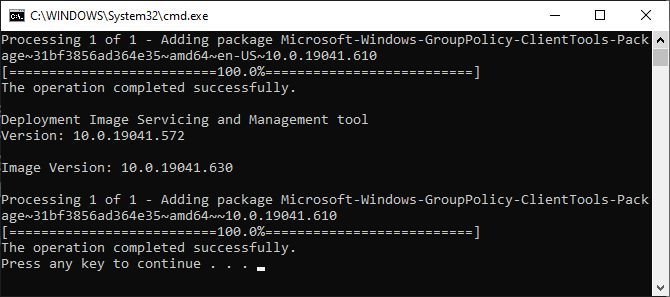
At present endeavor to open gpedit.msc every bit described in a higher place. If you lot can't find gpedit.msc using the search, exist certain to try opening it using the Run window.
Courtesy to ITECHTICS for pointing us to this method.
How to Modify Group Policy Editor Settings
Now that you can access the Local Grouping Policy Editor, what are you going to practice with it?
The number of settings available in the Group Policy Editor has been shrinking, and things you used to be able to exercise now require a registry tweak. Simply you can yet observe a few gems, and we'll show you how.
Inside the Group Policy Editor, you can find settings affecting the Computer Configuration or the User Configuration and three sub-categories for each of them. Browse the Administrative Templates to observe the almost interesting settings.
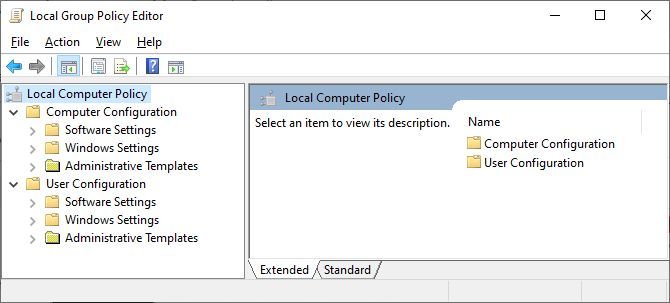
Change Windows Update Settings
Let'southward have a look at Computer Configuration > Administrative Templates > Windows Components > Windows Update, anybody's most favorite Windows feature. You'll detect that most of the settings here are Not configured.
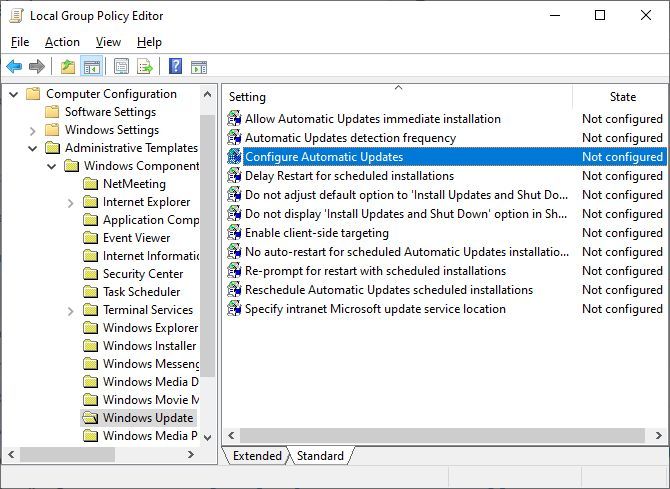
To change one of the settings, for example, to Configure Automatic Updates, double-click the item, and then review the available settings in the properties window that pops upward, and modify them to your preferences. In this example, yous could change the setting to Enabled, and then cull option 3 - Windows Auto download and notify for install, followed by your preferred installation 24-hour interval and time. When you're done, click Use.
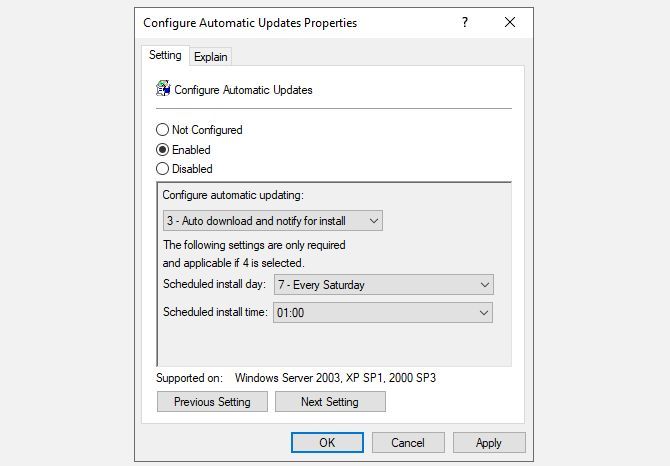
The Group Policy Editor also offers settings to suspension or end Windows Update and ways to control Driver Updates in Windows 10.
Adjust Windows Installer Defaults
Are you sharing your calculator with others and wand to forestall them from installing software? Head to Computer Configuration > Administrative Templates > Windows Installer > Disable Windows Installer** and enable this option for not-managed apps only or always.
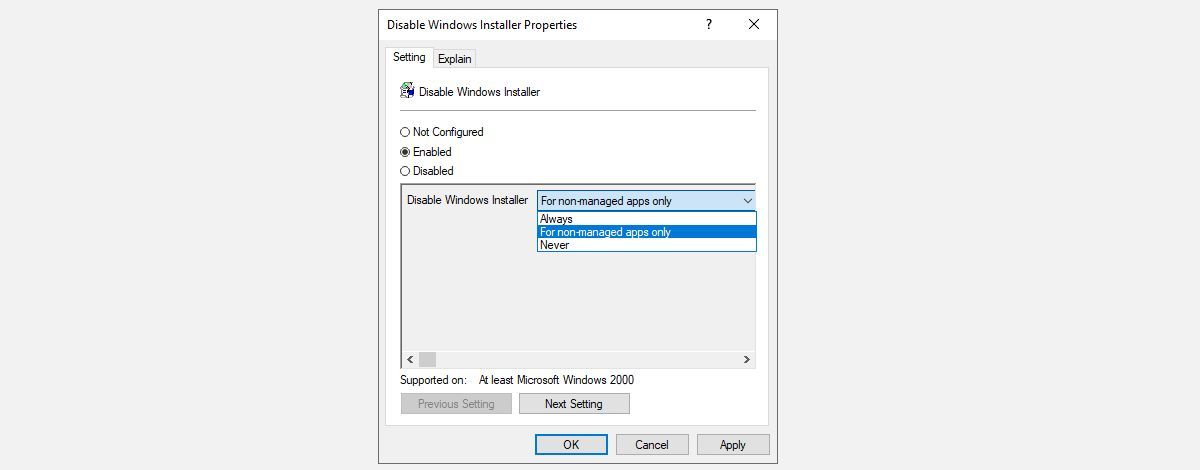
Other Windows Installer-related settings y'all can activate include:
- Always install with elevated privileges
- Prohibit rollback or patching
- Logging
- Prohibit User Installs
- Prohibit removal of updates
Be sure to read the description for each to understand what each setting does. Go on in listen that settings applied within Computer Configuration employ to all users. If yous desire to limit only specific users, switch to the User Configuration track instead.
Level Up With Windows Group Policy
The Group Policy Editor is a treasure trove of powerful Windows settings. While its importance has declined since the introduction of Windows 10 and will farther lose importance when Windows 11 launches, it still offers many means to customize your Windows setup. And now Dwelling users have admission to these settings, too.
Source: https://www.makeuseof.com/tag/access-group-policy-editor-even-windows-home-settings-try/
0 Response to "Easy Way to Erase Former All Group Policy From Windows Vista"
Post a Comment